Human Resource Management Project 1: BT's HRM Practices Analysis
VerifiedAdded on 2020/07/22
|14
|4131
|40
Project
AI Summary
This project provides a comprehensive analysis of Human Resource Management (HRM) practices within British Telecommunications (BT) Group. It begins with an introduction to the purpose and functions of HRM, emphasizing its importance in developing employee productivity and profitability within an international company. The project delves into the strengths and weaknesses of different recruitment and selection approaches, contrasting internal and external recruiting methods, and systematic and unsystematic selection processes. It then explores the benefits of various HRM practices for both employers and employees, including employee relations, performance appraisal systems, and training programs. The analysis extends to the impact of these practices on employee relations, decision-making, and the role of employment legislation. The project highlights how effective HRM contributes to organizational goals, employee development, and overall business success, providing insights into BT Group's strategies for managing its diverse workforce and maintaining a positive and productive work environment.
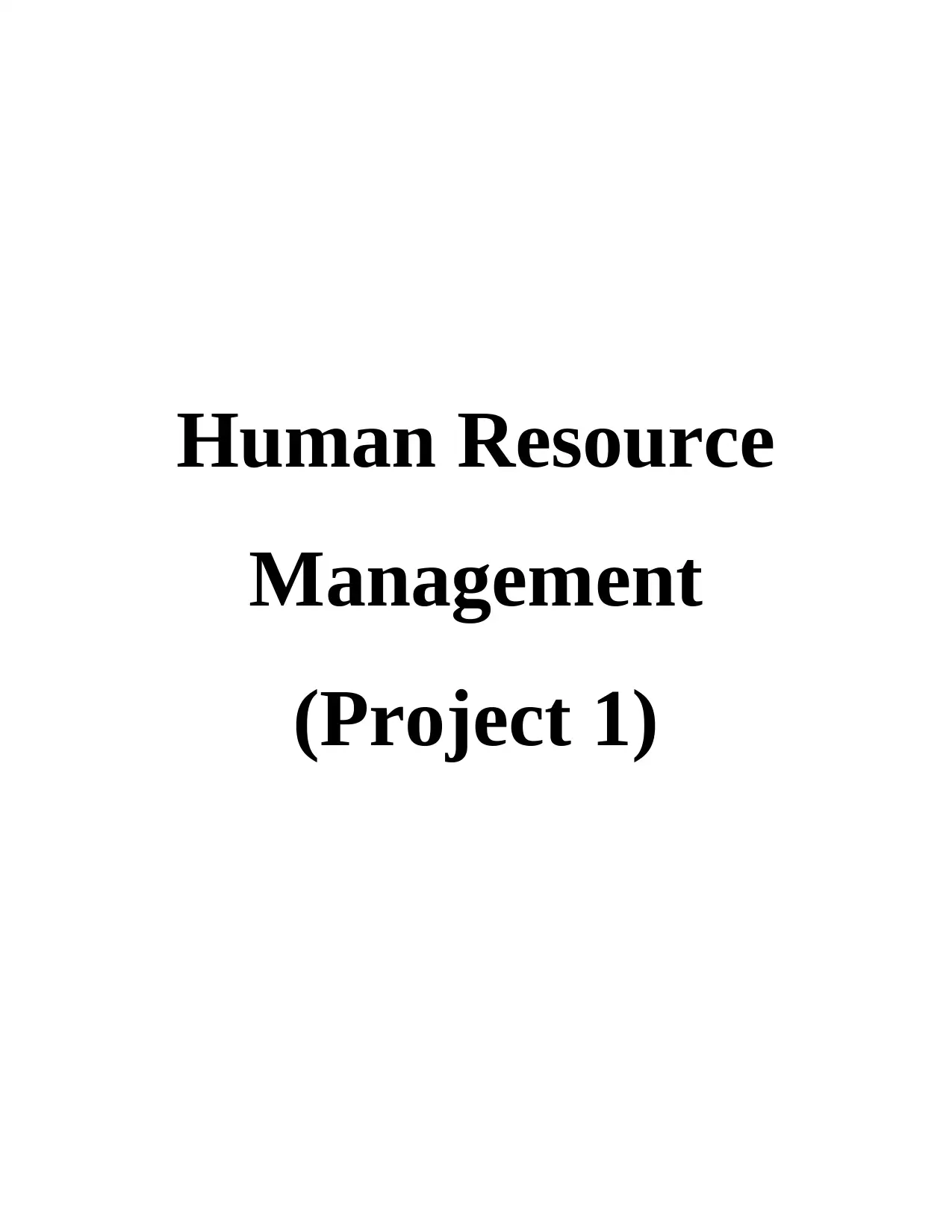
Human Resource
Management
(Project 1)
Management
(Project 1)
Paraphrase This Document
Need a fresh take? Get an instant paraphrase of this document with our AI Paraphraser
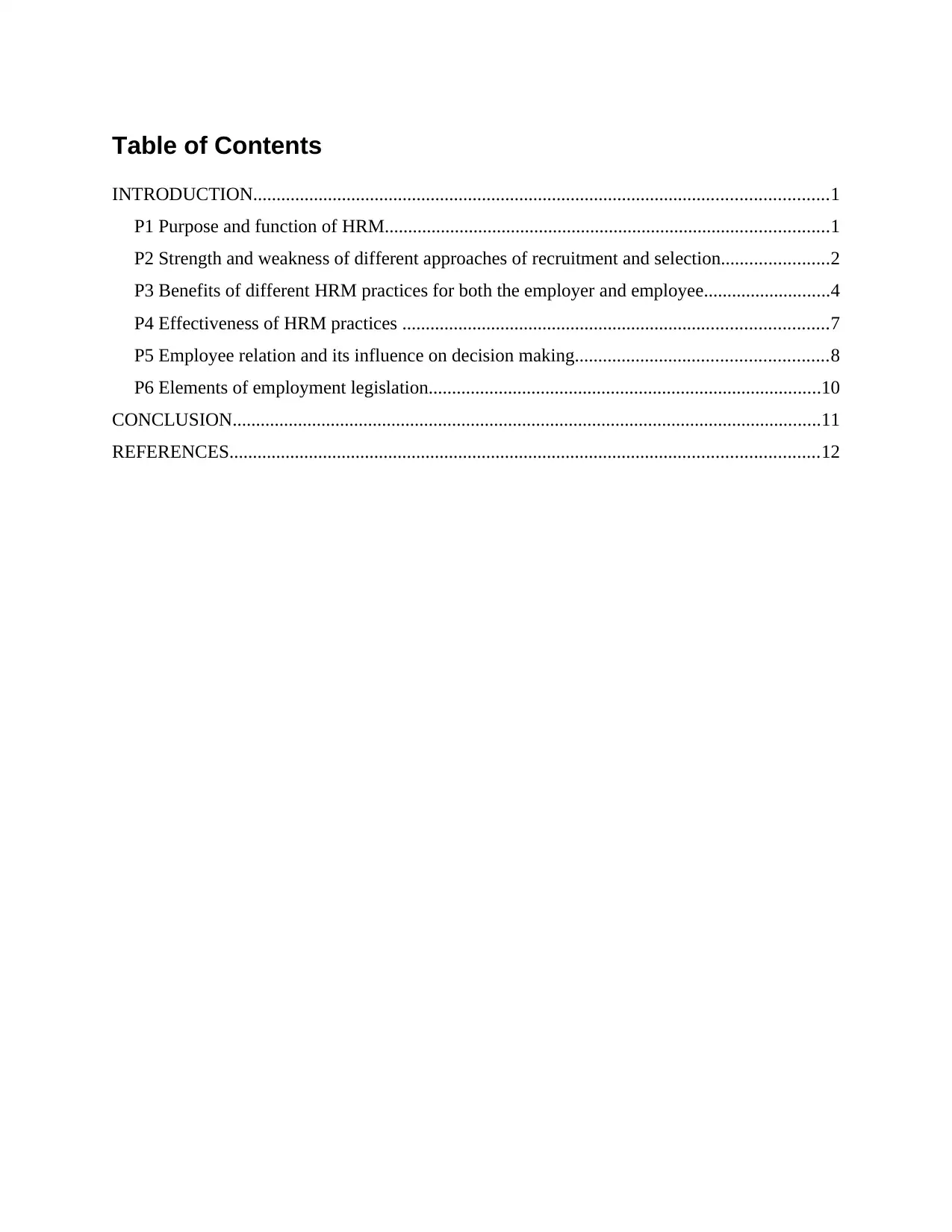
Table of Contents
INTRODUCTION...........................................................................................................................1
P1 Purpose and function of HRM...............................................................................................1
P2 Strength and weakness of different approaches of recruitment and selection.......................2
P3 Benefits of different HRM practices for both the employer and employee...........................4
P4 Effectiveness of HRM practices ...........................................................................................7
P5 Employee relation and its influence on decision making......................................................8
P6 Elements of employment legislation....................................................................................10
CONCLUSION..............................................................................................................................11
REFERENCES..............................................................................................................................12
INTRODUCTION...........................................................................................................................1
P1 Purpose and function of HRM...............................................................................................1
P2 Strength and weakness of different approaches of recruitment and selection.......................2
P3 Benefits of different HRM practices for both the employer and employee...........................4
P4 Effectiveness of HRM practices ...........................................................................................7
P5 Employee relation and its influence on decision making......................................................8
P6 Elements of employment legislation....................................................................................10
CONCLUSION..............................................................................................................................11
REFERENCES..............................................................................................................................12
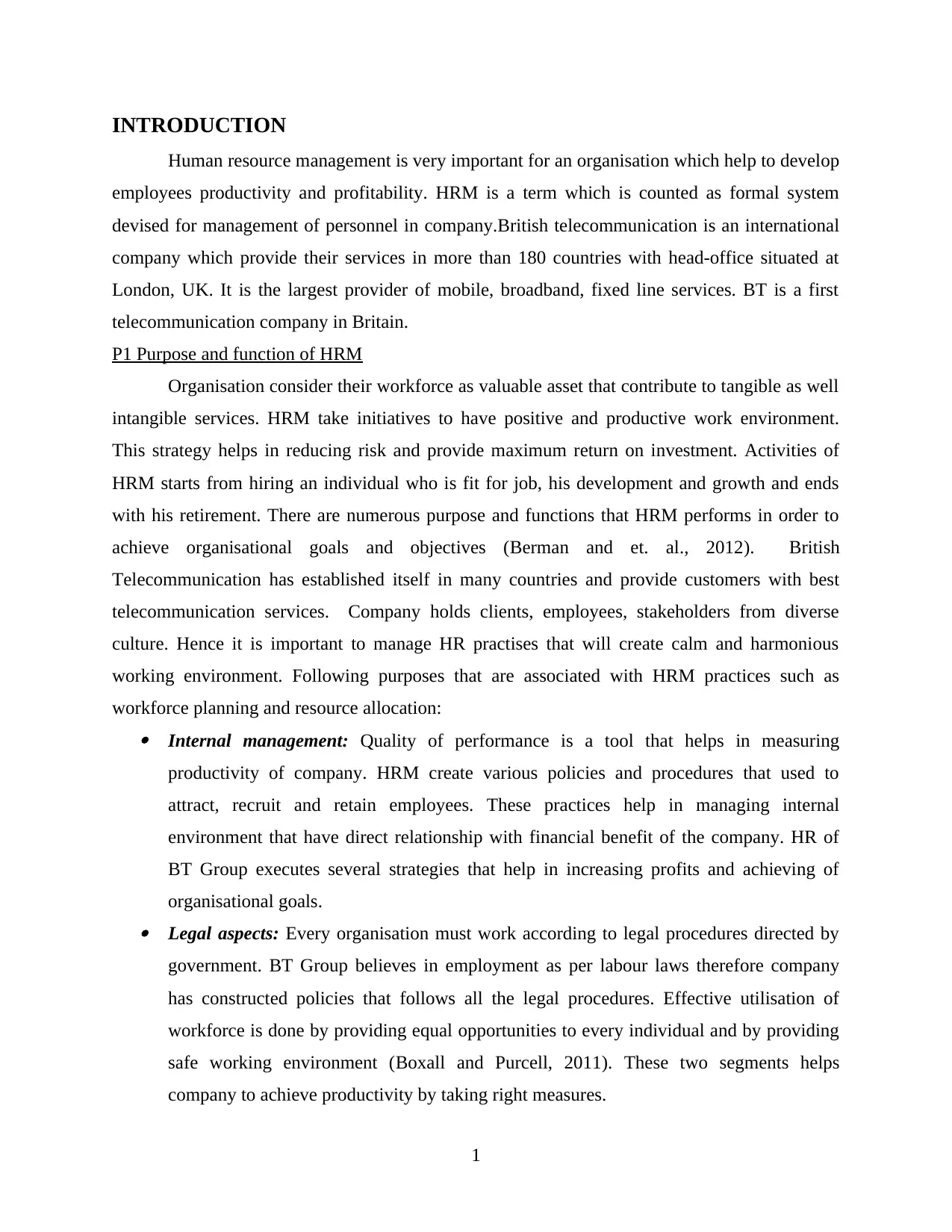
INTRODUCTION
Human resource management is very important for an organisation which help to develop
employees productivity and profitability. HRM is a term which is counted as formal system
devised for management of personnel in company.British telecommunication is an international
company which provide their services in more than 180 countries with head-office situated at
London, UK. It is the largest provider of mobile, broadband, fixed line services. BT is a first
telecommunication company in Britain.
P1 Purpose and function of HRM
Organisation consider their workforce as valuable asset that contribute to tangible as well
intangible services. HRM take initiatives to have positive and productive work environment.
This strategy helps in reducing risk and provide maximum return on investment. Activities of
HRM starts from hiring an individual who is fit for job, his development and growth and ends
with his retirement. There are numerous purpose and functions that HRM performs in order to
achieve organisational goals and objectives (Berman and et. al., 2012). British
Telecommunication has established itself in many countries and provide customers with best
telecommunication services. Company holds clients, employees, stakeholders from diverse
culture. Hence it is important to manage HR practises that will create calm and harmonious
working environment. Following purposes that are associated with HRM practices such as
workforce planning and resource allocation: Internal management: Quality of performance is a tool that helps in measuring
productivity of company. HRM create various policies and procedures that used to
attract, recruit and retain employees. These practices help in managing internal
environment that have direct relationship with financial benefit of the company. HR of
BT Group executes several strategies that help in increasing profits and achieving of
organisational goals. Legal aspects: Every organisation must work according to legal procedures directed by
government. BT Group believes in employment as per labour laws therefore company
has constructed policies that follows all the legal procedures. Effective utilisation of
workforce is done by providing equal opportunities to every individual and by providing
safe working environment (Boxall and Purcell, 2011). These two segments helps
company to achieve productivity by taking right measures.
1
Human resource management is very important for an organisation which help to develop
employees productivity and profitability. HRM is a term which is counted as formal system
devised for management of personnel in company.British telecommunication is an international
company which provide their services in more than 180 countries with head-office situated at
London, UK. It is the largest provider of mobile, broadband, fixed line services. BT is a first
telecommunication company in Britain.
P1 Purpose and function of HRM
Organisation consider their workforce as valuable asset that contribute to tangible as well
intangible services. HRM take initiatives to have positive and productive work environment.
This strategy helps in reducing risk and provide maximum return on investment. Activities of
HRM starts from hiring an individual who is fit for job, his development and growth and ends
with his retirement. There are numerous purpose and functions that HRM performs in order to
achieve organisational goals and objectives (Berman and et. al., 2012). British
Telecommunication has established itself in many countries and provide customers with best
telecommunication services. Company holds clients, employees, stakeholders from diverse
culture. Hence it is important to manage HR practises that will create calm and harmonious
working environment. Following purposes that are associated with HRM practices such as
workforce planning and resource allocation: Internal management: Quality of performance is a tool that helps in measuring
productivity of company. HRM create various policies and procedures that used to
attract, recruit and retain employees. These practices help in managing internal
environment that have direct relationship with financial benefit of the company. HR of
BT Group executes several strategies that help in increasing profits and achieving of
organisational goals. Legal aspects: Every organisation must work according to legal procedures directed by
government. BT Group believes in employment as per labour laws therefore company
has constructed policies that follows all the legal procedures. Effective utilisation of
workforce is done by providing equal opportunities to every individual and by providing
safe working environment (Boxall and Purcell, 2011). These two segments helps
company to achieve productivity by taking right measures.
1
⊘ This is a preview!⊘
Do you want full access?
Subscribe today to unlock all pages.

Trusted by 1+ million students worldwide
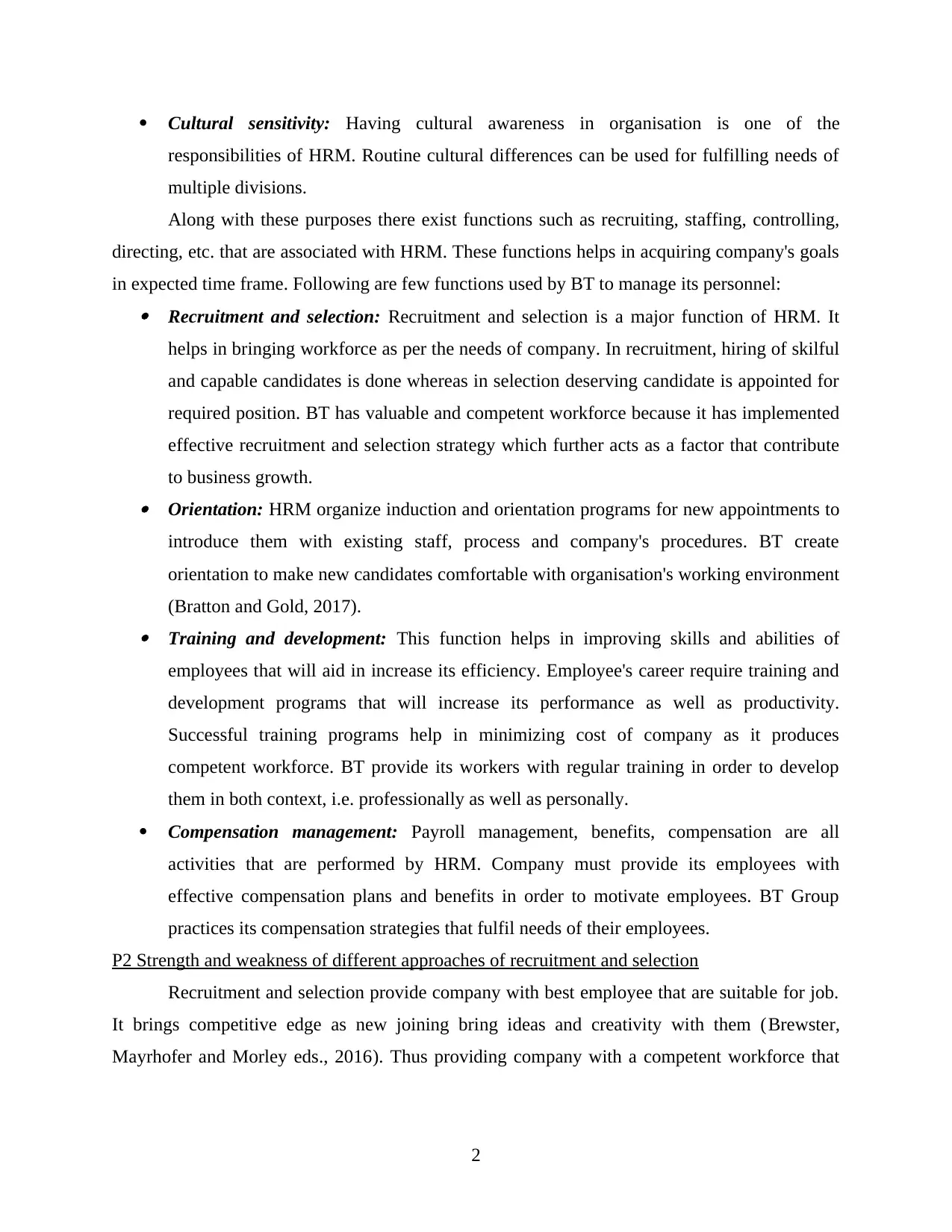
Cultural sensitivity: Having cultural awareness in organisation is one of the
responsibilities of HRM. Routine cultural differences can be used for fulfilling needs of
multiple divisions.
Along with these purposes there exist functions such as recruiting, staffing, controlling,
directing, etc. that are associated with HRM. These functions helps in acquiring company's goals
in expected time frame. Following are few functions used by BT to manage its personnel: Recruitment and selection: Recruitment and selection is a major function of HRM. It
helps in bringing workforce as per the needs of company. In recruitment, hiring of skilful
and capable candidates is done whereas in selection deserving candidate is appointed for
required position. BT has valuable and competent workforce because it has implemented
effective recruitment and selection strategy which further acts as a factor that contribute
to business growth. Orientation: HRM organize induction and orientation programs for new appointments to
introduce them with existing staff, process and company's procedures. BT create
orientation to make new candidates comfortable with organisation's working environment
(Bratton and Gold, 2017). Training and development: This function helps in improving skills and abilities of
employees that will aid in increase its efficiency. Employee's career require training and
development programs that will increase its performance as well as productivity.
Successful training programs help in minimizing cost of company as it produces
competent workforce. BT provide its workers with regular training in order to develop
them in both context, i.e. professionally as well as personally.
Compensation management: Payroll management, benefits, compensation are all
activities that are performed by HRM. Company must provide its employees with
effective compensation plans and benefits in order to motivate employees. BT Group
practices its compensation strategies that fulfil needs of their employees.
P2 Strength and weakness of different approaches of recruitment and selection
Recruitment and selection provide company with best employee that are suitable for job.
It brings competitive edge as new joining bring ideas and creativity with them (Brewster,
Mayrhofer and Morley eds., 2016). Thus providing company with a competent workforce that
2
responsibilities of HRM. Routine cultural differences can be used for fulfilling needs of
multiple divisions.
Along with these purposes there exist functions such as recruiting, staffing, controlling,
directing, etc. that are associated with HRM. These functions helps in acquiring company's goals
in expected time frame. Following are few functions used by BT to manage its personnel: Recruitment and selection: Recruitment and selection is a major function of HRM. It
helps in bringing workforce as per the needs of company. In recruitment, hiring of skilful
and capable candidates is done whereas in selection deserving candidate is appointed for
required position. BT has valuable and competent workforce because it has implemented
effective recruitment and selection strategy which further acts as a factor that contribute
to business growth. Orientation: HRM organize induction and orientation programs for new appointments to
introduce them with existing staff, process and company's procedures. BT create
orientation to make new candidates comfortable with organisation's working environment
(Bratton and Gold, 2017). Training and development: This function helps in improving skills and abilities of
employees that will aid in increase its efficiency. Employee's career require training and
development programs that will increase its performance as well as productivity.
Successful training programs help in minimizing cost of company as it produces
competent workforce. BT provide its workers with regular training in order to develop
them in both context, i.e. professionally as well as personally.
Compensation management: Payroll management, benefits, compensation are all
activities that are performed by HRM. Company must provide its employees with
effective compensation plans and benefits in order to motivate employees. BT Group
practices its compensation strategies that fulfil needs of their employees.
P2 Strength and weakness of different approaches of recruitment and selection
Recruitment and selection provide company with best employee that are suitable for job.
It brings competitive edge as new joining bring ideas and creativity with them (Brewster,
Mayrhofer and Morley eds., 2016). Thus providing company with a competent workforce that
2
Paraphrase This Document
Need a fresh take? Get an instant paraphrase of this document with our AI Paraphraser
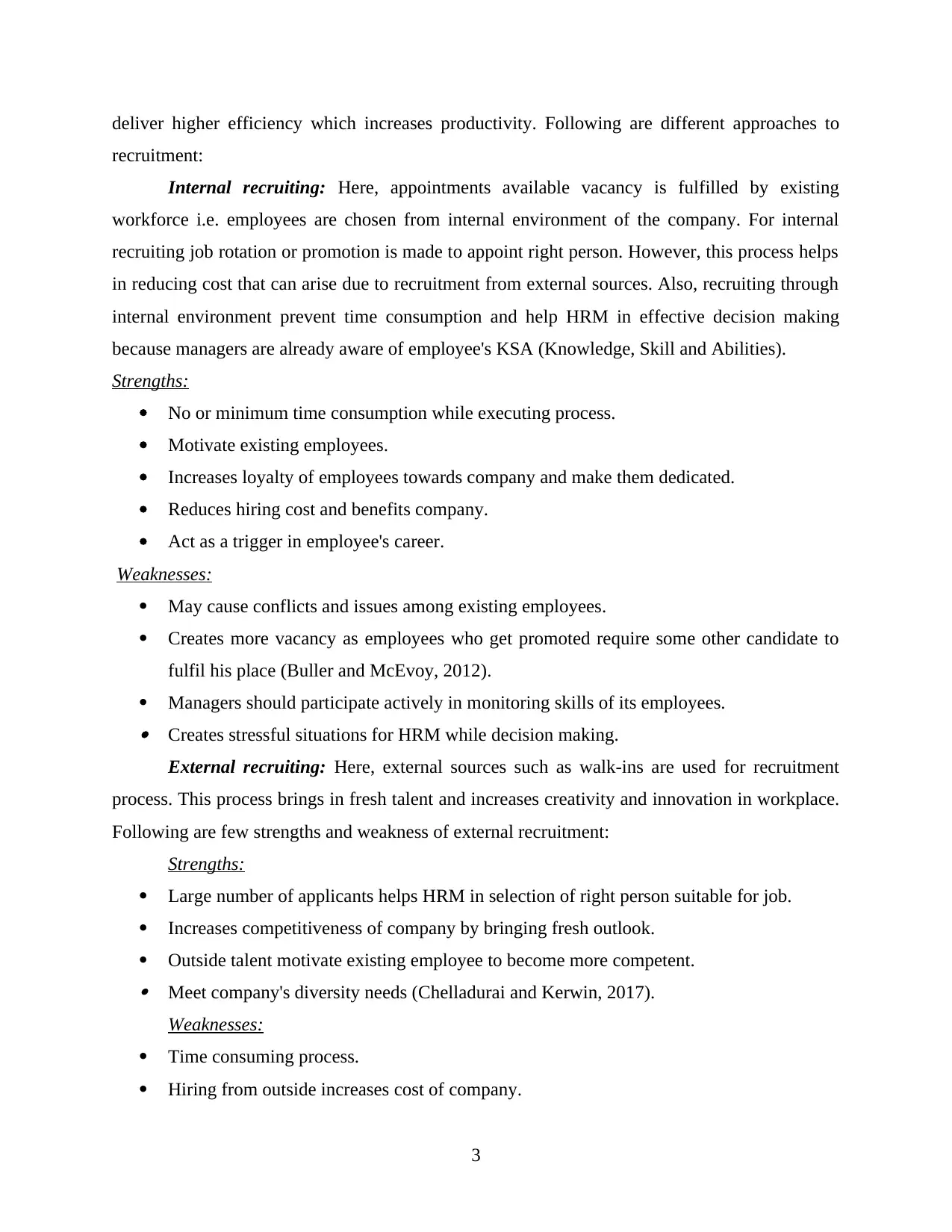
deliver higher efficiency which increases productivity. Following are different approaches to
recruitment:
Internal recruiting: Here, appointments available vacancy is fulfilled by existing
workforce i.e. employees are chosen from internal environment of the company. For internal
recruiting job rotation or promotion is made to appoint right person. However, this process helps
in reducing cost that can arise due to recruitment from external sources. Also, recruiting through
internal environment prevent time consumption and help HRM in effective decision making
because managers are already aware of employee's KSA (Knowledge, Skill and Abilities).
Strengths:
No or minimum time consumption while executing process.
Motivate existing employees.
Increases loyalty of employees towards company and make them dedicated.
Reduces hiring cost and benefits company.
Act as a trigger in employee's career.
Weaknesses:
May cause conflicts and issues among existing employees.
Creates more vacancy as employees who get promoted require some other candidate to
fulfil his place (Buller and McEvoy, 2012).
Managers should participate actively in monitoring skills of its employees. Creates stressful situations for HRM while decision making.
External recruiting: Here, external sources such as walk-ins are used for recruitment
process. This process brings in fresh talent and increases creativity and innovation in workplace.
Following are few strengths and weakness of external recruitment:
Strengths:
Large number of applicants helps HRM in selection of right person suitable for job.
Increases competitiveness of company by bringing fresh outlook.
Outside talent motivate existing employee to become more competent. Meet company's diversity needs (Chelladurai and Kerwin, 2017).
Weaknesses:
Time consuming process.
Hiring from outside increases cost of company.
3
recruitment:
Internal recruiting: Here, appointments available vacancy is fulfilled by existing
workforce i.e. employees are chosen from internal environment of the company. For internal
recruiting job rotation or promotion is made to appoint right person. However, this process helps
in reducing cost that can arise due to recruitment from external sources. Also, recruiting through
internal environment prevent time consumption and help HRM in effective decision making
because managers are already aware of employee's KSA (Knowledge, Skill and Abilities).
Strengths:
No or minimum time consumption while executing process.
Motivate existing employees.
Increases loyalty of employees towards company and make them dedicated.
Reduces hiring cost and benefits company.
Act as a trigger in employee's career.
Weaknesses:
May cause conflicts and issues among existing employees.
Creates more vacancy as employees who get promoted require some other candidate to
fulfil his place (Buller and McEvoy, 2012).
Managers should participate actively in monitoring skills of its employees. Creates stressful situations for HRM while decision making.
External recruiting: Here, external sources such as walk-ins are used for recruitment
process. This process brings in fresh talent and increases creativity and innovation in workplace.
Following are few strengths and weakness of external recruitment:
Strengths:
Large number of applicants helps HRM in selection of right person suitable for job.
Increases competitiveness of company by bringing fresh outlook.
Outside talent motivate existing employee to become more competent. Meet company's diversity needs (Chelladurai and Kerwin, 2017).
Weaknesses:
Time consuming process.
Hiring from outside increases cost of company.
3
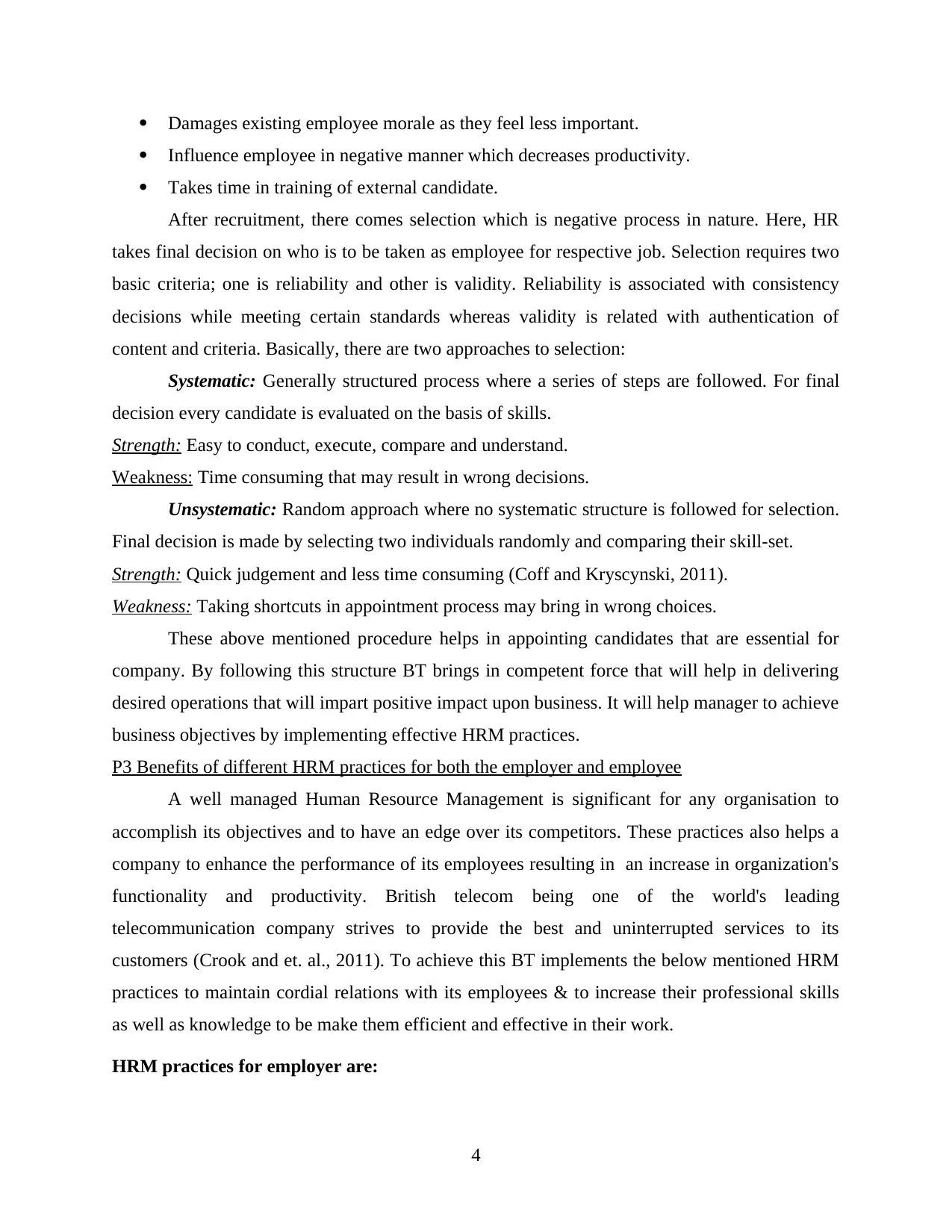
Damages existing employee morale as they feel less important.
Influence employee in negative manner which decreases productivity.
Takes time in training of external candidate.
After recruitment, there comes selection which is negative process in nature. Here, HR
takes final decision on who is to be taken as employee for respective job. Selection requires two
basic criteria; one is reliability and other is validity. Reliability is associated with consistency
decisions while meeting certain standards whereas validity is related with authentication of
content and criteria. Basically, there are two approaches to selection:
Systematic: Generally structured process where a series of steps are followed. For final
decision every candidate is evaluated on the basis of skills.
Strength: Easy to conduct, execute, compare and understand.
Weakness: Time consuming that may result in wrong decisions.
Unsystematic: Random approach where no systematic structure is followed for selection.
Final decision is made by selecting two individuals randomly and comparing their skill-set.
Strength: Quick judgement and less time consuming (Coff and Kryscynski, 2011).
Weakness: Taking shortcuts in appointment process may bring in wrong choices.
These above mentioned procedure helps in appointing candidates that are essential for
company. By following this structure BT brings in competent force that will help in delivering
desired operations that will impart positive impact upon business. It will help manager to achieve
business objectives by implementing effective HRM practices.
P3 Benefits of different HRM practices for both the employer and employee
A well managed Human Resource Management is significant for any organisation to
accomplish its objectives and to have an edge over its competitors. These practices also helps a
company to enhance the performance of its employees resulting in an increase in organization's
functionality and productivity. British telecom being one of the world's leading
telecommunication company strives to provide the best and uninterrupted services to its
customers (Crook and et. al., 2011). To achieve this BT implements the below mentioned HRM
practices to maintain cordial relations with its employees & to increase their professional skills
as well as knowledge to be make them efficient and effective in their work.
HRM practices for employer are:
4
Influence employee in negative manner which decreases productivity.
Takes time in training of external candidate.
After recruitment, there comes selection which is negative process in nature. Here, HR
takes final decision on who is to be taken as employee for respective job. Selection requires two
basic criteria; one is reliability and other is validity. Reliability is associated with consistency
decisions while meeting certain standards whereas validity is related with authentication of
content and criteria. Basically, there are two approaches to selection:
Systematic: Generally structured process where a series of steps are followed. For final
decision every candidate is evaluated on the basis of skills.
Strength: Easy to conduct, execute, compare and understand.
Weakness: Time consuming that may result in wrong decisions.
Unsystematic: Random approach where no systematic structure is followed for selection.
Final decision is made by selecting two individuals randomly and comparing their skill-set.
Strength: Quick judgement and less time consuming (Coff and Kryscynski, 2011).
Weakness: Taking shortcuts in appointment process may bring in wrong choices.
These above mentioned procedure helps in appointing candidates that are essential for
company. By following this structure BT brings in competent force that will help in delivering
desired operations that will impart positive impact upon business. It will help manager to achieve
business objectives by implementing effective HRM practices.
P3 Benefits of different HRM practices for both the employer and employee
A well managed Human Resource Management is significant for any organisation to
accomplish its objectives and to have an edge over its competitors. These practices also helps a
company to enhance the performance of its employees resulting in an increase in organization's
functionality and productivity. British telecom being one of the world's leading
telecommunication company strives to provide the best and uninterrupted services to its
customers (Crook and et. al., 2011). To achieve this BT implements the below mentioned HRM
practices to maintain cordial relations with its employees & to increase their professional skills
as well as knowledge to be make them efficient and effective in their work.
HRM practices for employer are:
4
⊘ This is a preview!⊘
Do you want full access?
Subscribe today to unlock all pages.

Trusted by 1+ million students worldwide
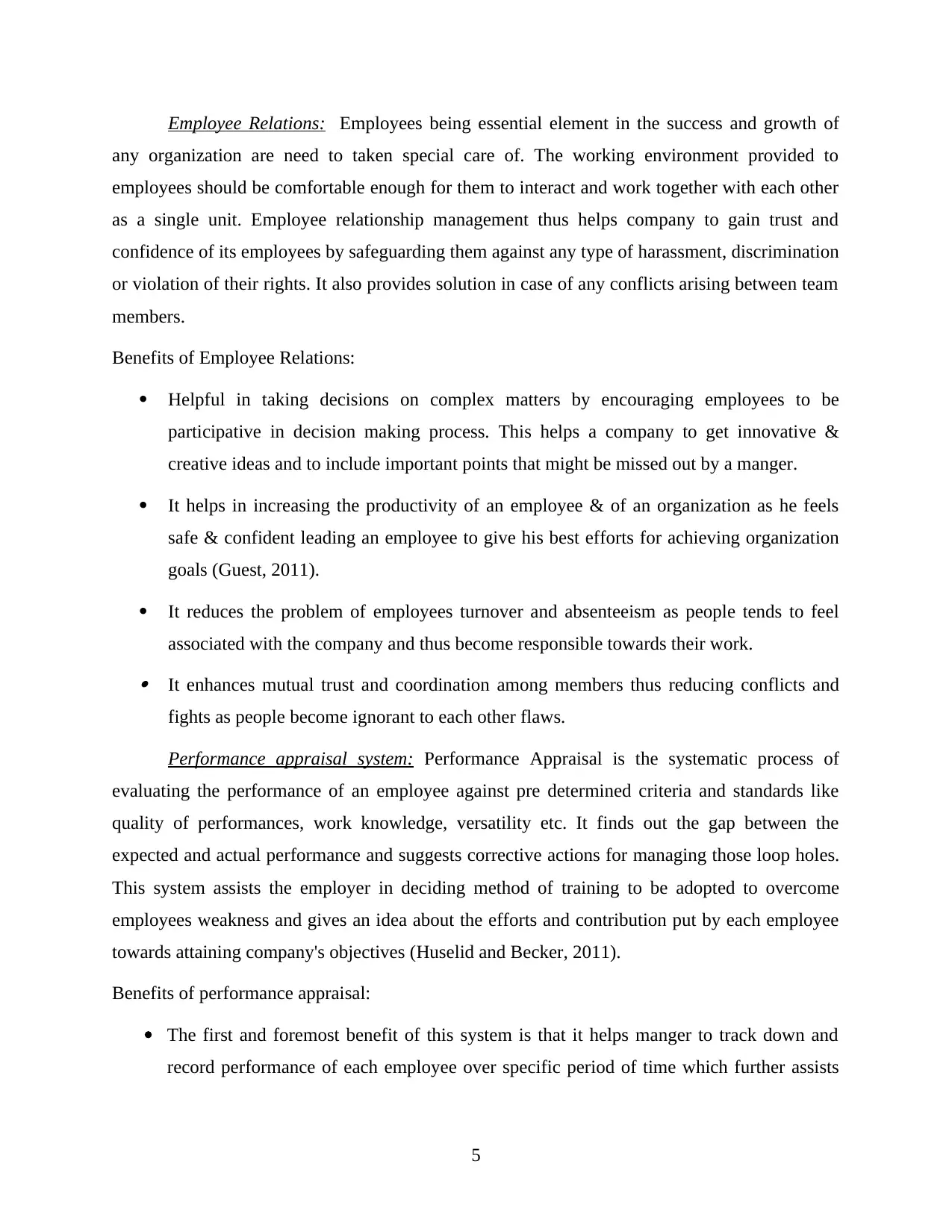
Employee Relations: Employees being essential element in the success and growth of
any organization are need to taken special care of. The working environment provided to
employees should be comfortable enough for them to interact and work together with each other
as a single unit. Employee relationship management thus helps company to gain trust and
confidence of its employees by safeguarding them against any type of harassment, discrimination
or violation of their rights. It also provides solution in case of any conflicts arising between team
members.
Benefits of Employee Relations:
Helpful in taking decisions on complex matters by encouraging employees to be
participative in decision making process. This helps a company to get innovative &
creative ideas and to include important points that might be missed out by a manger.
It helps in increasing the productivity of an employee & of an organization as he feels
safe & confident leading an employee to give his best efforts for achieving organization
goals (Guest, 2011).
It reduces the problem of employees turnover and absenteeism as people tends to feel
associated with the company and thus become responsible towards their work. It enhances mutual trust and coordination among members thus reducing conflicts and
fights as people become ignorant to each other flaws.
Performance appraisal system: Performance Appraisal is the systematic process of
evaluating the performance of an employee against pre determined criteria and standards like
quality of performances, work knowledge, versatility etc. It finds out the gap between the
expected and actual performance and suggests corrective actions for managing those loop holes.
This system assists the employer in deciding method of training to be adopted to overcome
employees weakness and gives an idea about the efforts and contribution put by each employee
towards attaining company's objectives (Huselid and Becker, 2011).
Benefits of performance appraisal:
The first and foremost benefit of this system is that it helps manger to track down and
record performance of each employee over specific period of time which further assists
5
any organization are need to taken special care of. The working environment provided to
employees should be comfortable enough for them to interact and work together with each other
as a single unit. Employee relationship management thus helps company to gain trust and
confidence of its employees by safeguarding them against any type of harassment, discrimination
or violation of their rights. It also provides solution in case of any conflicts arising between team
members.
Benefits of Employee Relations:
Helpful in taking decisions on complex matters by encouraging employees to be
participative in decision making process. This helps a company to get innovative &
creative ideas and to include important points that might be missed out by a manger.
It helps in increasing the productivity of an employee & of an organization as he feels
safe & confident leading an employee to give his best efforts for achieving organization
goals (Guest, 2011).
It reduces the problem of employees turnover and absenteeism as people tends to feel
associated with the company and thus become responsible towards their work. It enhances mutual trust and coordination among members thus reducing conflicts and
fights as people become ignorant to each other flaws.
Performance appraisal system: Performance Appraisal is the systematic process of
evaluating the performance of an employee against pre determined criteria and standards like
quality of performances, work knowledge, versatility etc. It finds out the gap between the
expected and actual performance and suggests corrective actions for managing those loop holes.
This system assists the employer in deciding method of training to be adopted to overcome
employees weakness and gives an idea about the efforts and contribution put by each employee
towards attaining company's objectives (Huselid and Becker, 2011).
Benefits of performance appraisal:
The first and foremost benefit of this system is that it helps manger to track down and
record performance of each employee over specific period of time which further assists
5
Paraphrase This Document
Need a fresh take? Get an instant paraphrase of this document with our AI Paraphraser
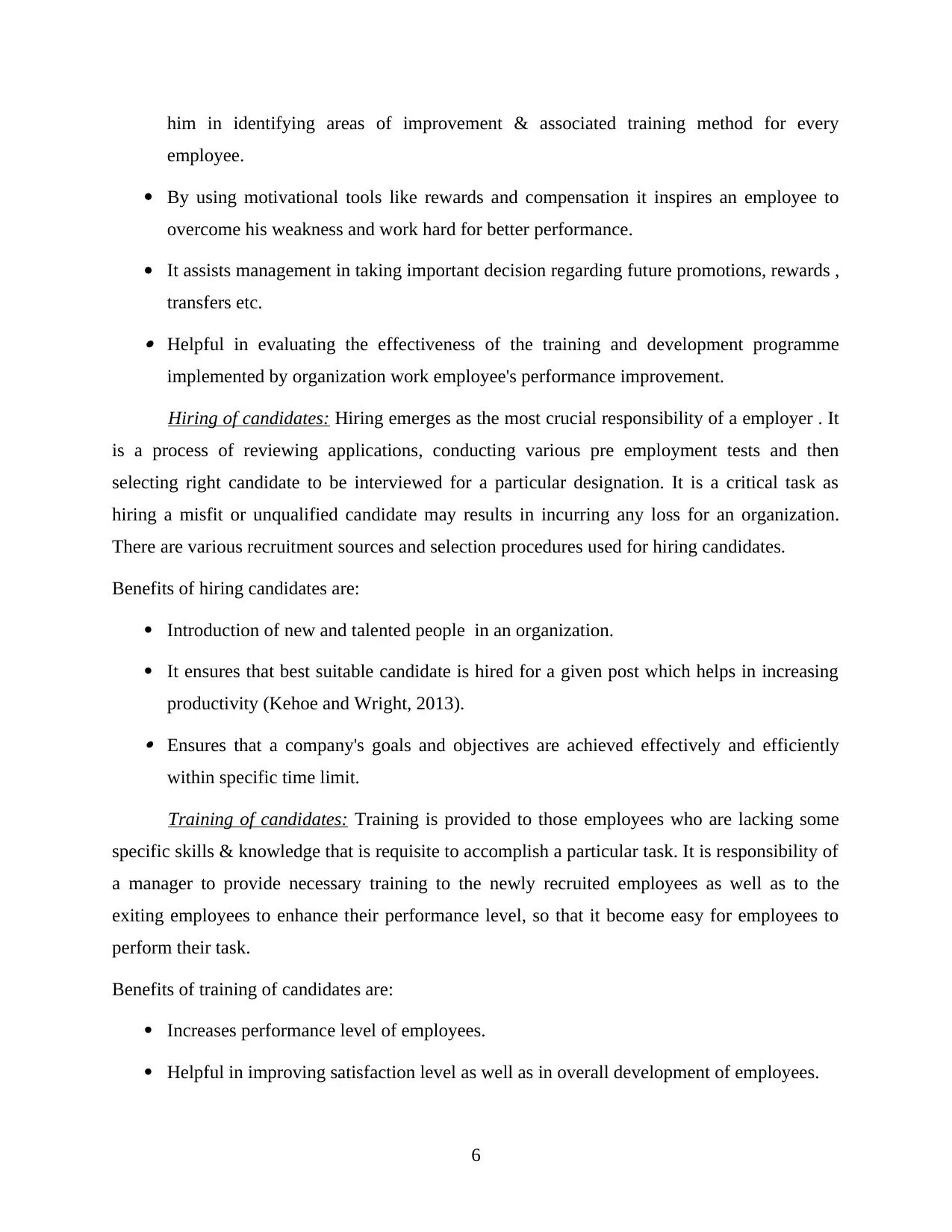
him in identifying areas of improvement & associated training method for every
employee.
By using motivational tools like rewards and compensation it inspires an employee to
overcome his weakness and work hard for better performance.
It assists management in taking important decision regarding future promotions, rewards ,
transfers etc. Helpful in evaluating the effectiveness of the training and development programme
implemented by organization work employee's performance improvement.
Hiring of candidates: Hiring emerges as the most crucial responsibility of a employer . It
is a process of reviewing applications, conducting various pre employment tests and then
selecting right candidate to be interviewed for a particular designation. It is a critical task as
hiring a misfit or unqualified candidate may results in incurring any loss for an organization.
There are various recruitment sources and selection procedures used for hiring candidates.
Benefits of hiring candidates are:
Introduction of new and talented people in an organization.
It ensures that best suitable candidate is hired for a given post which helps in increasing
productivity (Kehoe and Wright, 2013). Ensures that a company's goals and objectives are achieved effectively and efficiently
within specific time limit.
Training of candidates: Training is provided to those employees who are lacking some
specific skills & knowledge that is requisite to accomplish a particular task. It is responsibility of
a manager to provide necessary training to the newly recruited employees as well as to the
exiting employees to enhance their performance level, so that it become easy for employees to
perform their task.
Benefits of training of candidates are:
Increases performance level of employees.
Helpful in improving satisfaction level as well as in overall development of employees.
6
employee.
By using motivational tools like rewards and compensation it inspires an employee to
overcome his weakness and work hard for better performance.
It assists management in taking important decision regarding future promotions, rewards ,
transfers etc. Helpful in evaluating the effectiveness of the training and development programme
implemented by organization work employee's performance improvement.
Hiring of candidates: Hiring emerges as the most crucial responsibility of a employer . It
is a process of reviewing applications, conducting various pre employment tests and then
selecting right candidate to be interviewed for a particular designation. It is a critical task as
hiring a misfit or unqualified candidate may results in incurring any loss for an organization.
There are various recruitment sources and selection procedures used for hiring candidates.
Benefits of hiring candidates are:
Introduction of new and talented people in an organization.
It ensures that best suitable candidate is hired for a given post which helps in increasing
productivity (Kehoe and Wright, 2013). Ensures that a company's goals and objectives are achieved effectively and efficiently
within specific time limit.
Training of candidates: Training is provided to those employees who are lacking some
specific skills & knowledge that is requisite to accomplish a particular task. It is responsibility of
a manager to provide necessary training to the newly recruited employees as well as to the
exiting employees to enhance their performance level, so that it become easy for employees to
perform their task.
Benefits of training of candidates are:
Increases performance level of employees.
Helpful in improving satisfaction level as well as in overall development of employees.
6
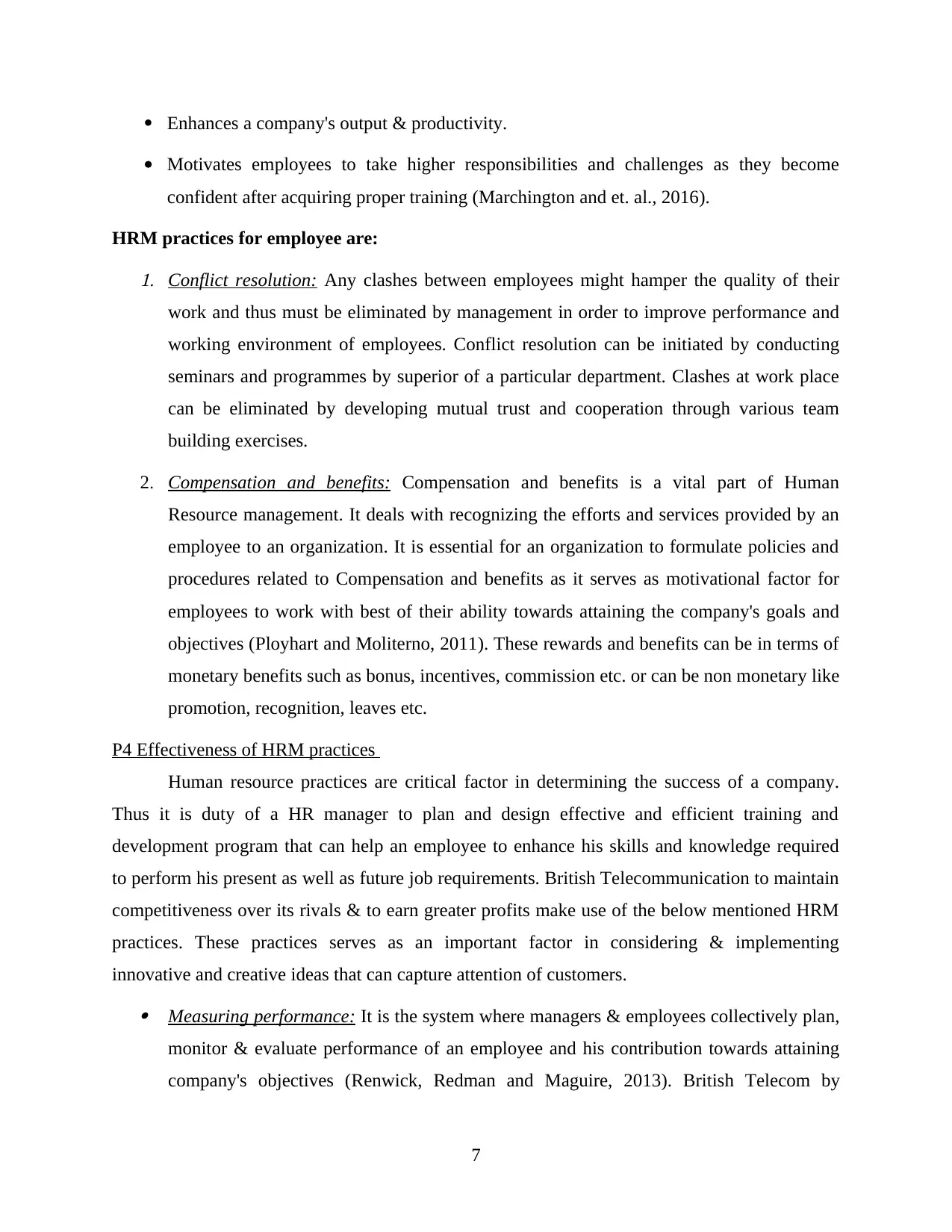
Enhances a company's output & productivity.
Motivates employees to take higher responsibilities and challenges as they become
confident after acquiring proper training (Marchington and et. al., 2016).
HRM practices for employee are:1. Conflict resolution: Any clashes between employees might hamper the quality of their
work and thus must be eliminated by management in order to improve performance and
working environment of employees. Conflict resolution can be initiated by conducting
seminars and programmes by superior of a particular department. Clashes at work place
can be eliminated by developing mutual trust and cooperation through various team
building exercises.
2. Compensation and benefits: Compensation and benefits is a vital part of Human
Resource management. It deals with recognizing the efforts and services provided by an
employee to an organization. It is essential for an organization to formulate policies and
procedures related to Compensation and benefits as it serves as motivational factor for
employees to work with best of their ability towards attaining the company's goals and
objectives (Ployhart and Moliterno, 2011). These rewards and benefits can be in terms of
monetary benefits such as bonus, incentives, commission etc. or can be non monetary like
promotion, recognition, leaves etc.
P4 Effectiveness of HRM practices
Human resource practices are critical factor in determining the success of a company.
Thus it is duty of a HR manager to plan and design effective and efficient training and
development program that can help an employee to enhance his skills and knowledge required
to perform his present as well as future job requirements. British Telecommunication to maintain
competitiveness over its rivals & to earn greater profits make use of the below mentioned HRM
practices. These practices serves as an important factor in considering & implementing
innovative and creative ideas that can capture attention of customers. Measuring performance: It is the system where managers & employees collectively plan,
monitor & evaluate performance of an employee and his contribution towards attaining
company's objectives (Renwick, Redman and Maguire, 2013). British Telecom by
7
Motivates employees to take higher responsibilities and challenges as they become
confident after acquiring proper training (Marchington and et. al., 2016).
HRM practices for employee are:1. Conflict resolution: Any clashes between employees might hamper the quality of their
work and thus must be eliminated by management in order to improve performance and
working environment of employees. Conflict resolution can be initiated by conducting
seminars and programmes by superior of a particular department. Clashes at work place
can be eliminated by developing mutual trust and cooperation through various team
building exercises.
2. Compensation and benefits: Compensation and benefits is a vital part of Human
Resource management. It deals with recognizing the efforts and services provided by an
employee to an organization. It is essential for an organization to formulate policies and
procedures related to Compensation and benefits as it serves as motivational factor for
employees to work with best of their ability towards attaining the company's goals and
objectives (Ployhart and Moliterno, 2011). These rewards and benefits can be in terms of
monetary benefits such as bonus, incentives, commission etc. or can be non monetary like
promotion, recognition, leaves etc.
P4 Effectiveness of HRM practices
Human resource practices are critical factor in determining the success of a company.
Thus it is duty of a HR manager to plan and design effective and efficient training and
development program that can help an employee to enhance his skills and knowledge required
to perform his present as well as future job requirements. British Telecommunication to maintain
competitiveness over its rivals & to earn greater profits make use of the below mentioned HRM
practices. These practices serves as an important factor in considering & implementing
innovative and creative ideas that can capture attention of customers. Measuring performance: It is the system where managers & employees collectively plan,
monitor & evaluate performance of an employee and his contribution towards attaining
company's objectives (Renwick, Redman and Maguire, 2013). British Telecom by
7
⊘ This is a preview!⊘
Do you want full access?
Subscribe today to unlock all pages.

Trusted by 1+ million students worldwide
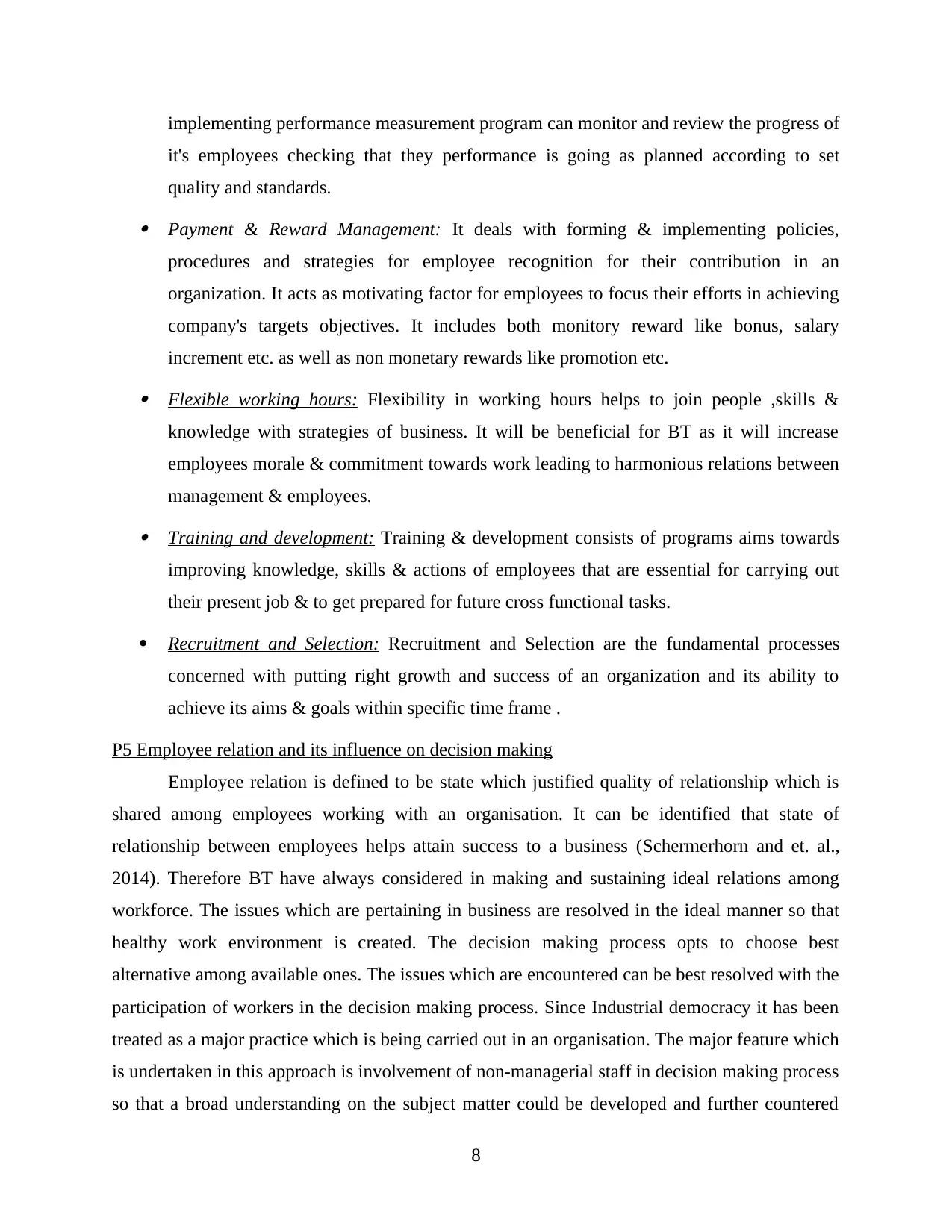
implementing performance measurement program can monitor and review the progress of
it's employees checking that they performance is going as planned according to set
quality and standards. Payment & Reward Management: It deals with forming & implementing policies,
procedures and strategies for employee recognition for their contribution in an
organization. It acts as motivating factor for employees to focus their efforts in achieving
company's targets objectives. It includes both monitory reward like bonus, salary
increment etc. as well as non monetary rewards like promotion etc. Flexible working hours: Flexibility in working hours helps to join people ,skills &
knowledge with strategies of business. It will be beneficial for BT as it will increase
employees morale & commitment towards work leading to harmonious relations between
management & employees. Training and development: Training & development consists of programs aims towards
improving knowledge, skills & actions of employees that are essential for carrying out
their present job & to get prepared for future cross functional tasks.
Recruitment and Selection: Recruitment and Selection are the fundamental processes
concerned with putting right growth and success of an organization and its ability to
achieve its aims & goals within specific time frame .
P5 Employee relation and its influence on decision making
Employee relation is defined to be state which justified quality of relationship which is
shared among employees working with an organisation. It can be identified that state of
relationship between employees helps attain success to a business (Schermerhorn and et. al.,
2014). Therefore BT have always considered in making and sustaining ideal relations among
workforce. The issues which are pertaining in business are resolved in the ideal manner so that
healthy work environment is created. The decision making process opts to choose best
alternative among available ones. The issues which are encountered can be best resolved with the
participation of workers in the decision making process. Since Industrial democracy it has been
treated as a major practice which is being carried out in an organisation. The major feature which
is undertaken in this approach is involvement of non-managerial staff in decision making process
so that a broad understanding on the subject matter could be developed and further countered
8
it's employees checking that they performance is going as planned according to set
quality and standards. Payment & Reward Management: It deals with forming & implementing policies,
procedures and strategies for employee recognition for their contribution in an
organization. It acts as motivating factor for employees to focus their efforts in achieving
company's targets objectives. It includes both monitory reward like bonus, salary
increment etc. as well as non monetary rewards like promotion etc. Flexible working hours: Flexibility in working hours helps to join people ,skills &
knowledge with strategies of business. It will be beneficial for BT as it will increase
employees morale & commitment towards work leading to harmonious relations between
management & employees. Training and development: Training & development consists of programs aims towards
improving knowledge, skills & actions of employees that are essential for carrying out
their present job & to get prepared for future cross functional tasks.
Recruitment and Selection: Recruitment and Selection are the fundamental processes
concerned with putting right growth and success of an organization and its ability to
achieve its aims & goals within specific time frame .
P5 Employee relation and its influence on decision making
Employee relation is defined to be state which justified quality of relationship which is
shared among employees working with an organisation. It can be identified that state of
relationship between employees helps attain success to a business (Schermerhorn and et. al.,
2014). Therefore BT have always considered in making and sustaining ideal relations among
workforce. The issues which are pertaining in business are resolved in the ideal manner so that
healthy work environment is created. The decision making process opts to choose best
alternative among available ones. The issues which are encountered can be best resolved with the
participation of workers in the decision making process. Since Industrial democracy it has been
treated as a major practice which is being carried out in an organisation. The major feature which
is undertaken in this approach is involvement of non-managerial staff in decision making process
so that a broad understanding on the subject matter could be developed and further countered
8
Paraphrase This Document
Need a fresh take? Get an instant paraphrase of this document with our AI Paraphraser
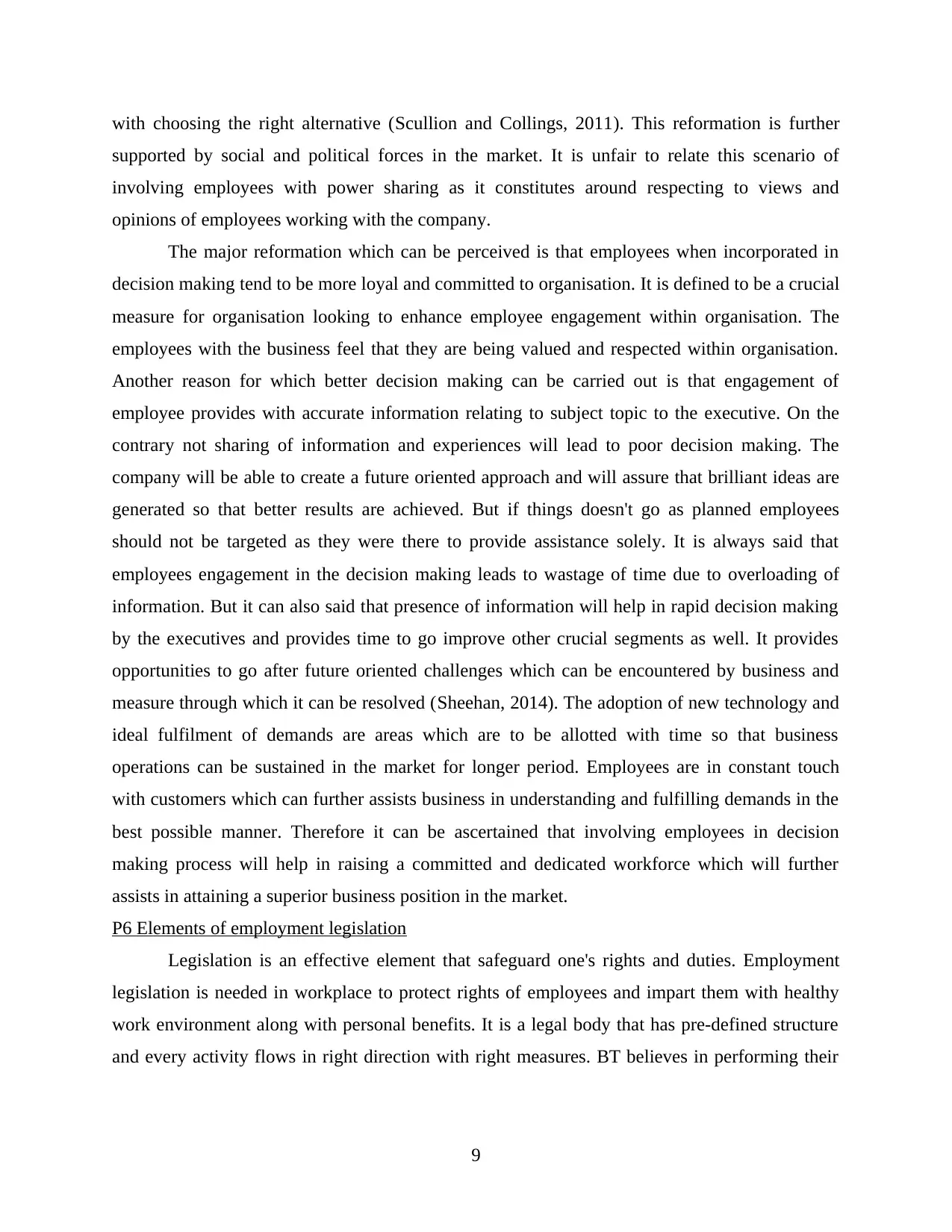
with choosing the right alternative (Scullion and Collings, 2011). This reformation is further
supported by social and political forces in the market. It is unfair to relate this scenario of
involving employees with power sharing as it constitutes around respecting to views and
opinions of employees working with the company.
The major reformation which can be perceived is that employees when incorporated in
decision making tend to be more loyal and committed to organisation. It is defined to be a crucial
measure for organisation looking to enhance employee engagement within organisation. The
employees with the business feel that they are being valued and respected within organisation.
Another reason for which better decision making can be carried out is that engagement of
employee provides with accurate information relating to subject topic to the executive. On the
contrary not sharing of information and experiences will lead to poor decision making. The
company will be able to create a future oriented approach and will assure that brilliant ideas are
generated so that better results are achieved. But if things doesn't go as planned employees
should not be targeted as they were there to provide assistance solely. It is always said that
employees engagement in the decision making leads to wastage of time due to overloading of
information. But it can also said that presence of information will help in rapid decision making
by the executives and provides time to go improve other crucial segments as well. It provides
opportunities to go after future oriented challenges which can be encountered by business and
measure through which it can be resolved (Sheehan, 2014). The adoption of new technology and
ideal fulfilment of demands are areas which are to be allotted with time so that business
operations can be sustained in the market for longer period. Employees are in constant touch
with customers which can further assists business in understanding and fulfilling demands in the
best possible manner. Therefore it can be ascertained that involving employees in decision
making process will help in raising a committed and dedicated workforce which will further
assists in attaining a superior business position in the market.
P6 Elements of employment legislation
Legislation is an effective element that safeguard one's rights and duties. Employment
legislation is needed in workplace to protect rights of employees and impart them with healthy
work environment along with personal benefits. It is a legal body that has pre-defined structure
and every activity flows in right direction with right measures. BT believes in performing their
9
supported by social and political forces in the market. It is unfair to relate this scenario of
involving employees with power sharing as it constitutes around respecting to views and
opinions of employees working with the company.
The major reformation which can be perceived is that employees when incorporated in
decision making tend to be more loyal and committed to organisation. It is defined to be a crucial
measure for organisation looking to enhance employee engagement within organisation. The
employees with the business feel that they are being valued and respected within organisation.
Another reason for which better decision making can be carried out is that engagement of
employee provides with accurate information relating to subject topic to the executive. On the
contrary not sharing of information and experiences will lead to poor decision making. The
company will be able to create a future oriented approach and will assure that brilliant ideas are
generated so that better results are achieved. But if things doesn't go as planned employees
should not be targeted as they were there to provide assistance solely. It is always said that
employees engagement in the decision making leads to wastage of time due to overloading of
information. But it can also said that presence of information will help in rapid decision making
by the executives and provides time to go improve other crucial segments as well. It provides
opportunities to go after future oriented challenges which can be encountered by business and
measure through which it can be resolved (Sheehan, 2014). The adoption of new technology and
ideal fulfilment of demands are areas which are to be allotted with time so that business
operations can be sustained in the market for longer period. Employees are in constant touch
with customers which can further assists business in understanding and fulfilling demands in the
best possible manner. Therefore it can be ascertained that involving employees in decision
making process will help in raising a committed and dedicated workforce which will further
assists in attaining a superior business position in the market.
P6 Elements of employment legislation
Legislation is an effective element that safeguard one's rights and duties. Employment
legislation is needed in workplace to protect rights of employees and impart them with healthy
work environment along with personal benefits. It is a legal body that has pre-defined structure
and every activity flows in right direction with right measures. BT believes in performing their
9
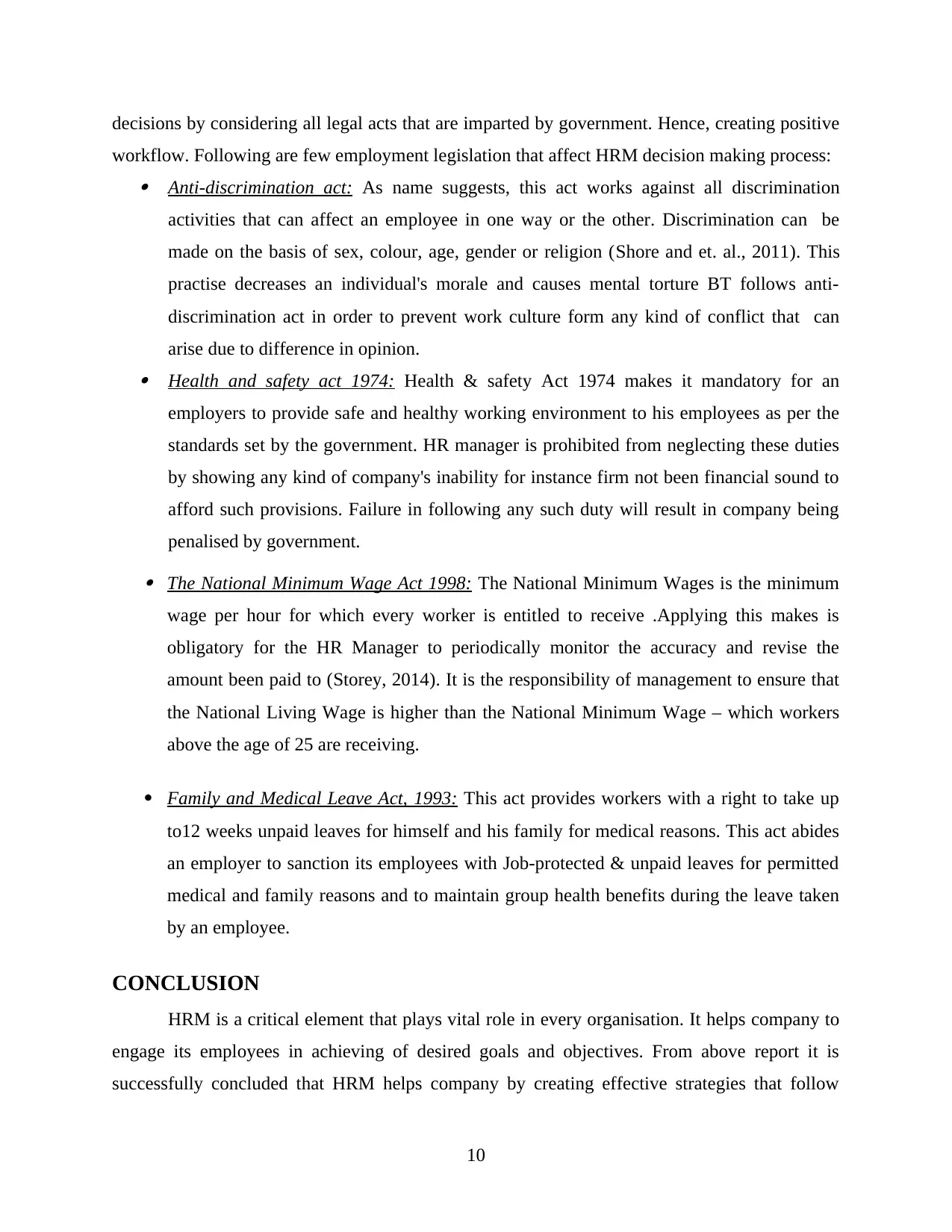
decisions by considering all legal acts that are imparted by government. Hence, creating positive
workflow. Following are few employment legislation that affect HRM decision making process: Anti-discrimination act: As name suggests, this act works against all discrimination
activities that can affect an employee in one way or the other. Discrimination can be
made on the basis of sex, colour, age, gender or religion (Shore and et. al., 2011). This
practise decreases an individual's morale and causes mental torture BT follows anti-
discrimination act in order to prevent work culture form any kind of conflict that can
arise due to difference in opinion. Health and safety act 1974: Health & safety Act 1974 makes it mandatory for an
employers to provide safe and healthy working environment to his employees as per the
standards set by the government. HR manager is prohibited from neglecting these duties
by showing any kind of company's inability for instance firm not been financial sound to
afford such provisions. Failure in following any such duty will result in company being
penalised by government. The National Minimum Wage Act 1998: The National Minimum Wages is the minimum
wage per hour for which every worker is entitled to receive .Applying this makes is
obligatory for the HR Manager to periodically monitor the accuracy and revise the
amount been paid to (Storey, 2014). It is the responsibility of management to ensure that
the National Living Wage is higher than the National Minimum Wage – which workers
above the age of 25 are receiving.
Family and Medical Leave Act, 1993: This act provides workers with a right to take up
to12 weeks unpaid leaves for himself and his family for medical reasons. This act abides
an employer to sanction its employees with Job-protected & unpaid leaves for permitted
medical and family reasons and to maintain group health benefits during the leave taken
by an employee.
CONCLUSION
HRM is a critical element that plays vital role in every organisation. It helps company to
engage its employees in achieving of desired goals and objectives. From above report it is
successfully concluded that HRM helps company by creating effective strategies that follow
10
workflow. Following are few employment legislation that affect HRM decision making process: Anti-discrimination act: As name suggests, this act works against all discrimination
activities that can affect an employee in one way or the other. Discrimination can be
made on the basis of sex, colour, age, gender or religion (Shore and et. al., 2011). This
practise decreases an individual's morale and causes mental torture BT follows anti-
discrimination act in order to prevent work culture form any kind of conflict that can
arise due to difference in opinion. Health and safety act 1974: Health & safety Act 1974 makes it mandatory for an
employers to provide safe and healthy working environment to his employees as per the
standards set by the government. HR manager is prohibited from neglecting these duties
by showing any kind of company's inability for instance firm not been financial sound to
afford such provisions. Failure in following any such duty will result in company being
penalised by government. The National Minimum Wage Act 1998: The National Minimum Wages is the minimum
wage per hour for which every worker is entitled to receive .Applying this makes is
obligatory for the HR Manager to periodically monitor the accuracy and revise the
amount been paid to (Storey, 2014). It is the responsibility of management to ensure that
the National Living Wage is higher than the National Minimum Wage – which workers
above the age of 25 are receiving.
Family and Medical Leave Act, 1993: This act provides workers with a right to take up
to12 weeks unpaid leaves for himself and his family for medical reasons. This act abides
an employer to sanction its employees with Job-protected & unpaid leaves for permitted
medical and family reasons and to maintain group health benefits during the leave taken
by an employee.
CONCLUSION
HRM is a critical element that plays vital role in every organisation. It helps company to
engage its employees in achieving of desired goals and objectives. From above report it is
successfully concluded that HRM helps company by creating effective strategies that follow
10
⊘ This is a preview!⊘
Do you want full access?
Subscribe today to unlock all pages.

Trusted by 1+ million students worldwide
1 out of 14
Related Documents
Your All-in-One AI-Powered Toolkit for Academic Success.
+13062052269
info@desklib.com
Available 24*7 on WhatsApp / Email
![[object Object]](/_next/static/media/star-bottom.7253800d.svg)
Unlock your academic potential
Copyright © 2020–2025 A2Z Services. All Rights Reserved. Developed and managed by ZUCOL.




